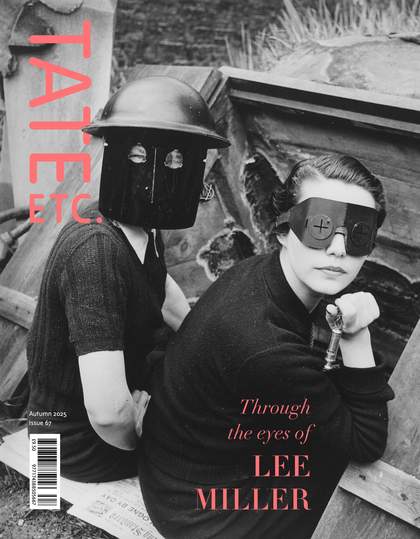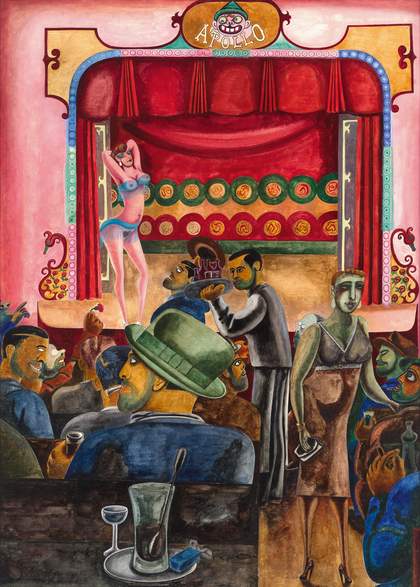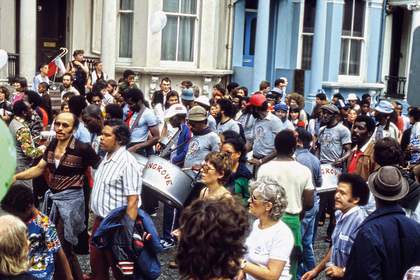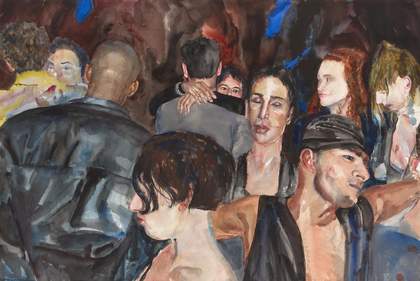
David Remfry
Heat of the Night (1992)
Tate
I've always been interested in parties and dancing – the underbelly, if you like. It started when I was at art school in Hull in the 1960s. I used to go to the Locarno and various other clubs at night, and make surreptitious drawings. It’s been a passion ever since.
When I go out, I feel like both an onlooker and a participant. I really want to be involved, but being an artist takes precedence. I’m there to soak it up, to absorb as much of it as I can. I have a reasonably good visual memory – for about 24 or 48 hours max – and a lot of my paintings of dancing consist of remembered fragments of images and feelings, all superimposed into one picture back in the studio.
Back then, I was a bit of a turpentine and oil paint junkie. But in 1979, I developed sarcoidosis, an autoimmune disease, and turned to watercolour because it was easier to do in my condition. Then, I kind of fell in love with it. It is a great medium to use spontaneously and for capturing a sense of motion.
Heat of the Night 1992 was a special painting for me. It signalled a branching out from the sort of water-colours I had been doing before and a move towards something a bit grittier. There is a sense of warmth behind the figures, and you can see perspiration on their faces. They’re all engaged with themselves, except for one person right in the middle of the painting, who is looking out. It was painted in London just before I moved to New York – initially for a year, to paint pictures for an exhibition, before I ended up living at the Chelsea Hotel for 20 years – and it was oddly prescient of the sort of work I would make there. In New York, the nightlife was blissful. There were some really dodgy clubs that were just up my street, and events such as Wigstock, the drag festival, fed into my work too.
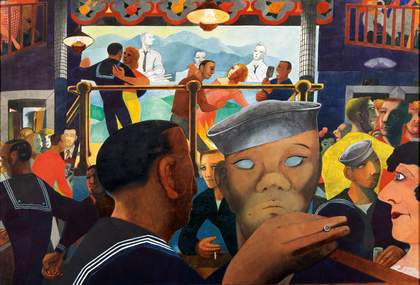
Edward Burra
Izzy Orts 1937
© The estate of Edward Burra, courtesy Lefevre Fine Art, London. Photo © National Galleries of Scotland
I think this is where I gel with an artist like Edward Burra. In his paintings of nightlife, you can tell he was an onlooker, but you can see he wants to be in it too. Walking around the exhibition at Tate Britain recently, I was blown away by how contemporary his work feels, and the magnificent way in which he handled water-colour. He applies it very differently from the way I do – it’s not as transparent and looks almost like gouache.
You could look at a painting like Burra’s Boston dance-hall scene Izzy Orts 1937 indefinitely – the hanging lamps, the dancers in the background, the ghostly faces peering out, and someone to the left of the stage who could be the artist himself. I love the figure in the foreground, with those beautiful, bright, white lines going over his shoulder. Burra seems to shift between styles in the same painting. It’s full of invention. The truth is, it’s a masterpiece.
David Remfry is an artist who lives and works in London. Heat of the Night was presented by the artist in 2025. A new monograph on his work is published by Lund Humphries. He talked to Enrico Tassi.
Edward Burra, Tate Britain, until 19 October. In partnership with Lockton. With additional support from the Edward Burra Exhibition Supporters Circle and Tate Members.

